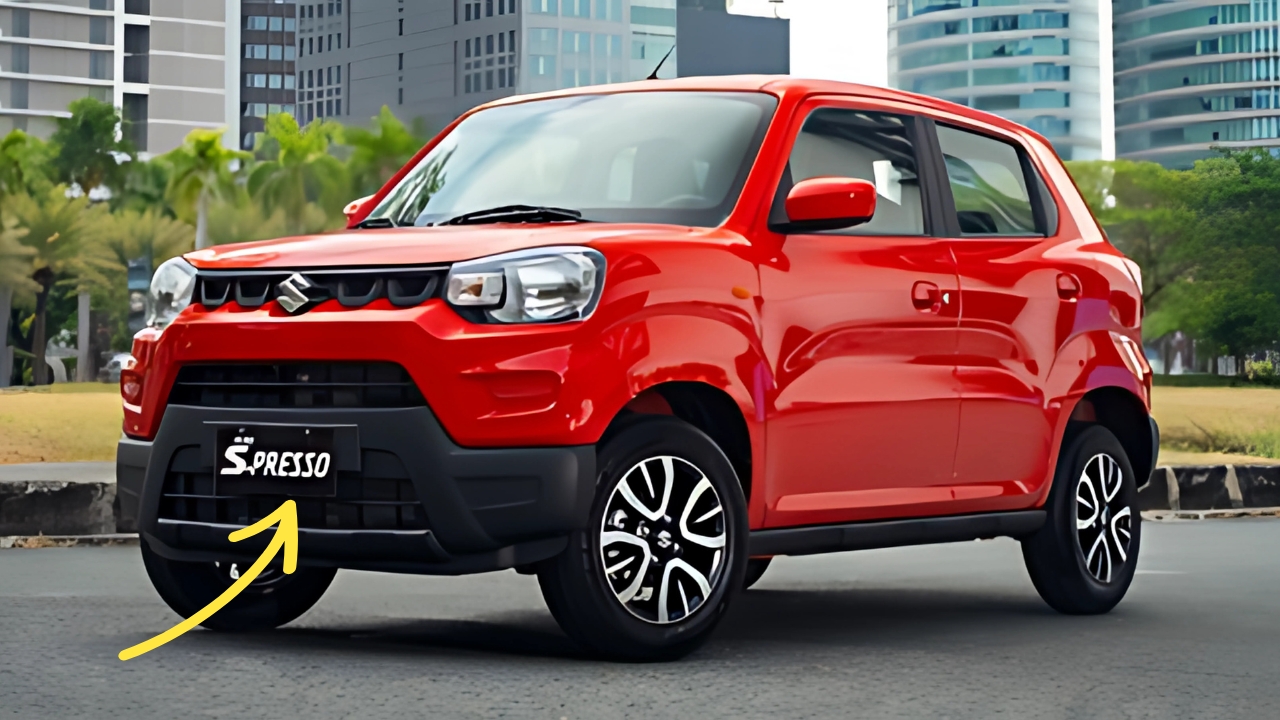Maruti S-Presso: In the densely populated small car segment of the Indian automotive market, standing out requires genuine innovation rather than incremental improvements.
When Maruti Suzuki introduced the S-Presso in late 2019, it represented the company’s interpretation of what an entry-level vehicle could be in a market increasingly favoring SUV-inspired design cues.
Now several years into its lifecycle, the S-Presso continues to challenge conventional categorization while addressing the fundamental needs of first-time car buyers and urban commuters.
Maruti S-Presso: Design Philosophy: The Micro-SUV Approach
The S-Presso’s most distinctive feature is undoubtedly its upright, boxy silhouette that draws inspiration from larger SUVs while maintaining dimensions suitable for congested urban environments.
Standing 3,565mm long, 1,520mm wide, and 1,564mm tall, the S-Presso maximizes interior volume within a compact footprint.
The 180mm ground clearance further reinforces its mini-SUV positioning, offering practical benefits when navigating rough roads and speed breakers common throughout India.
The front fascia features a squared-off design with a distinctive grille structure that houses the Suzuki emblem. The headlamps, positioned on either side of this grille, utilize a conventional halogen setup rather than the LED arrangements found in more premium offerings.
The bumper incorporates black cladding that continues along the wheel arches and lower body, lending the vehicle a more rugged appearance while providing some protection against minor scrapes.
In profile, the S-Presso’s tall greenhouse becomes particularly apparent, with an almost vertical windshield and rear window maximizing the perception of interior space.
The 14-inch wheels, while modest in size, are positioned at the corners of the vehicle to optimize interior packaging and stability. Higher trim levels receive wheel covers that provide a more finished appearance without the cost implications of alloy wheels.
The rear continues the squared-off theme with high-mounted tail lamps and a simple bumper design. While not revolutionary in execution, the overall design successfully communicates the vehicle’s positioning as an affordable, urban-friendly interpretation of SUV design language.
Interior: Maximizing Space Efficiency
Inside, the S-Presso employs a centrally-mounted instrument cluster—a design choice that polarizes opinion but allows for a more efficient dashboard layout.
This digital display incorporates the speedometer, fuel gauge, and trip computer in a compact unit that’s easily visible to both driver and front passenger.
Surrounding this central element is a color-matched panel that adds a touch of visual interest to an otherwise straightforward interior design.
The dashboard follows a minimalist approach with circular air vents and straightforward controls for the climate system.
Higher trim levels incorporate a 7-inch touchscreen infotainment system that supports smartphone connectivity through Apple CarPlay and Android Auto—features once reserved for more premium segments but now increasingly expected even in entry-level vehicles.
Interior space utilization is impressive given the external dimensions. The high roof and upright seating position create a sense of airiness that belies the vehicle’s compact footprint.
Front occupants enjoy adequate headroom and legroom, while the rear bench can accommodate two adults in reasonable comfort or three for shorter journeys.
The 270-liter boot capacity is sufficient for everyday needs, though loading bulkier items requires folding the rear seats.
Material quality reflects the S-Presso’s positioning, with durable plastics dominating the cabin. While not plush, the surfaces are well-assembled with consistent panel gaps and no obvious creaks or rattles—a testament to Maruti Suzuki’s manufacturing expertise even at this price point.
Powertrain and Driving Dynamics
Under the hood, the S-Presso employs Maruti’s familiar K10B 1.0-liter three-cylinder petrol engine, producing 68 horsepower and 90 Nm of torque.
This powerplant is offered with either a 5-speed manual transmission or an automated manual transmission (AMT) branded as Auto Gear Shift (AGS) by Maruti Suzuki.
Later updates introduced a factory-fitted CNG option that reduces power output slightly but significantly improves running costs—an important consideration for the target demographic.
The driving experience prioritizes ease of use over engagement, with light controls making the S-Presso particularly suited to urban environments.
The high seating position provides good visibility, while the tight turning radius of 4.5 meters facilitates maneuvering in confined spaces. The steering, while lacking in feedback, offers sufficient precision for daily driving scenarios.
Performance is adequate rather than inspiring, with the manual variant capable of reaching 100 km/h in approximately 14 seconds.
More relevant to the intended usage pattern is the fuel efficiency, with Maruti claiming figures between 21-24 km/l depending on transmission choice and fuel type—numbers that translate to genuinely economical running costs.
Ride quality is reasonable for a vehicle with such a short wheelbase, though sharp impacts can filter through to the cabin.
At highway speeds, the tall body structure is susceptible to crosswinds, requiring occasional steering corrections to maintain course. These characteristics reflect the S-Presso’s primary focus on urban mobility rather than long-distance cruising.
Safety and Technology
Safety features in the S-Presso include a driver airbag as standard, with a passenger airbag available on higher trims or as an option on base variants.
ABS with EBD, rear parking sensors, front seat belt reminders, and a high-speed warning system are included across the range to comply with Indian safety regulations.
The body structure incorporates Suzuki’s HEARTECT platform, designed to better absorb and distribute crash energy.
On the technology front, the aforementioned 7-inch touchscreen infotainment system serves as the centerpiece in higher trims, offering smartphone connectivity and Bluetooth functionality.
Steering-mounted controls for audio and phone operations enhance convenience, while power windows, central locking, and an audio system with USB and auxiliary inputs round out the feature set. While not lavishly equipped, the S-Presso offers the essential connectivity features expected by contemporary consumers.
Market Impact and Positioning
The S-Presso entered a market segment traditionally dominated by conventional hatchbacks, offering a distinctive alternative that capitalized on the growing preference for SUV-inspired styling.
Positioned between the Alto and Wagon R in Maruti’s extensive small car portfolio, it provides another option for buyers seeking something different within a similar price bracket.
The vehicle’s competitive pricing, combined with Maruti Suzuki’s extensive sales and service network, has contributed to its success in attracting first-time car buyers, particularly in smaller cities and towns where the elevated ground clearance offers practical benefits on imperfect road surfaces.
The availability of a factory-fitted CNG option further enhances its appeal in regions where this fuel is readily available, offering substantial savings on running costs.
Maruti S-Presso:
The Maruti Suzuki S-Presso represents a thoughtful response to evolving consumer preferences in the entry-level segment.
By incorporating SUV-inspired design elements and a practical interior layout within an affordable package, it delivers a product that stands apart from conventional small cars without demanding a significant premium.
While not without compromises—particularly in areas like safety equipment and refinement—the S-Presso successfully balances cost considerations with the features most valued by its target audience.
The result is a vehicle that offers genuine utility and character in a segment often defined by pragmatic compromises, demonstrating that affordability and personality need not be mutually exclusive.
As urban mobility continues to evolve, the S-Presso’s approach to maximizing interior space while minimizing external footprint represents a relevant interpretation of what entry-level transportation can offer in crowded metropolitan environments.
Whether viewed as a high-riding hatchback or a micro-SUV, it challenges segment conventions while remaining faithful to the core values that have defined Maruti Suzuki’s success in the Indian market.

